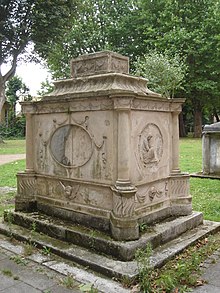Robert Wood (antiquarian)
Robert Wood (* 1716 or 1717 in Riverstown Castle near Dublin ; † September 9, 1771 in Putney near London ) was a British traveler, archaeologist , Undersecretary of State and Member of Parliament.
Life
Robert Wood was the son of a Presbyterian minister. He studied in Glasgow from 1730 to 1732 , at the Middle Temple in 1736 and in Padua in 1738 . In 1742/43 he made his first trip to the eastern Mediterranean.
From 1750 to 1753 he undertook a trip to the ancient sites of the Eastern Mediterranean with James Dawkins (1722–1757) and John Bouverie (1723–1750) as well as the draftsman and architect Giovanni Battista Borra (1712–1786). The voyage began in Naples on May 5, 1750 with a specially equipped ship, the Matilda . They first traveled to the Aegean Sea and the coasts of Asia Minor , where Bouverie died in September 1750. The journey continued to Egypt and Palestine . In the spring of 1751 they traveled to Syria , especially Palmyra and Baalbek , and returned to Naples on June 7, 1751 via Tripoli in what is now Lebanon, Cyprus and Greece . This trip is one of the first purely scientific research expeditions to the Eastern Mediterranean.
They tried to locate the original locations of ancient authors, such as Homers in the Skamandros Plain, and to document them in newly drawn maps, and bought antiques and old manuscripts to bring them to Great Britain. Based on the model of the Édifices antiques de Rome (1692) by the French architect Antoine Desgodetz (1653–1728), they made measurements of the ancient ruins in Palmyra and Baalbek . The results were published in 1753 and 1757 as elaborate tables with text by Wood, in parallel in an English and a French edition. They were among the earliest systematic publications of ancient architecture and had a great influence on the classical architecture of both Great Britain and the continent. For example, Friedrich Wilhelm von Erdmannsdorff used motifs from the two volumes in his buildings in Wörlitzer Park , such as the palace and the Pantheon. Heinrich Gentz adopted motifs from the Palmyra ribbon for the interior decoration of the Weimar City Palace . Gentz also recommended Woods engravings to the students of the Berlin Building Academy , where he taught, as they contained “the most splendid patterns for architectural decorations”, and in particular “very beautiful and rich ceilings”.
From 1753 to 1756 Wood was the companion of the young Duke of Bridgewater on his Grand Tour through Europe. In December 1756 he was Under Secretary in the Southern Department (later part of the Foreign Department ), an office he held until 1763 and then from 1768 to 1770 Under Secretary in the Northern Department. From 1761 until his death he was a member of the House of Commons for Brackley , Northamptonshire .
With his work An essay on the original genius of Homer , published in 1769 , he is one of the earliest serious researchers on Homer , in particular he tried to show that the Homeric work was initially created orally and only later became written.
Wood lies on the Putney Old Burial Ground in the Putney borough of London in a grave with an epitaph by Horace Walpole .
Fonts
- The ruins of Palmyra; otherwise Tedmore in the desart. London 1753 University Library Heidelberg .
- Les ruins de Palmyre, autrement dite Tedmor, au desert. London 1753 University Library Heidelberg .
- The ruins of Balbec, otherwise Heliopolis in Coelosyria. London 1757 University Library Heidelberg .
- Les Ruines de Balbec, autrement dite Heliopolis dans la Coelosyrie. London 1757.
- An essay on the original genius of Homer with a Comparative View of the Ancient and Present State of the Troade. London 1769 Internet Archive .
literature
- William Prideaux Courtney: Wood, Robert . In: Sidney Lee (Ed.): Dictionary of National Biography . Volume 62: Williamson - Worden. , MacMillan & Co, Smith, Elder & Co., New York City / London 1900, pp. 373 - 375 (English).
- CA Hutton: The travels of “Palmyra” Wood in 1750–51 . In: Journal of Hellenic Studies 47, 1927, pp. 102–128.
- TJB Spencer: Robert Wood and the problem of Troy in the eighteenth century . In: Journal of the Warburg and Courtauld Institutes 29, 1957, pp. 75-105. * Claire Pace: Gavin Hamilton's Wood and Dawkins discovering Palmyra: the dilettante as hero . In: Art History 4, 1981, pp. 271-290.
- John Summerson : Architecture in Britain 1530-1830 (= Pelican History of Art ). 9th Edition, Yale University Press, New Haven and London 1993, pp. 380-381.
- DM White: Wood, Robert. In: Henry Colin Gray Matthew, Brian Harrison (Eds.): Oxford Dictionary of National Biography , from the earliest times to the year 2000 (ODNB). Volume 60: Wolmark – Zuylestein. Oxford University Press, Oxford 2004, ISBN 0-19-861410-1 , pp. 135-137, ( oxforddnb.com license required ), as of 2004
- Heinz-Günther Nesselrath : Wood, Robert. In: Peter Kuhlmann , Helmuth Schneider (Hrsg.): History of the ancient sciences. Biographical Lexicon (= The New Pauly . Supplements. Volume 6). Metzler, Stuttgart / Weimar 2012, ISBN 978-3-476-02033-8 , Sp. 1336 f.
Web links
- Robert Wood in the UK MPs database
- Portrait of Allan Ramsay (1755)
Individual evidence
- ↑ a b c d e f g François Angelier: Dictionnaire des Voyageurs et Explorateurs occidentaux du XIIIe au XXe siècle . Pygmalion (Éditions Flammarion), Paris 2011, ISBN 978-2-7564-0156-0 , p. 711 .
| personal data | |
|---|---|
| SURNAME | Wood, Robert |
| BRIEF DESCRIPTION | British traveler, archaeologist, Undersecretary of State and Member of Parliament |
| DATE OF BIRTH | 1716 or 1717 |
| PLACE OF BIRTH | Riverstown Castle near Dublin |
| DATE OF DEATH | September 9, 1771 |
| Place of death | Putney near London |

